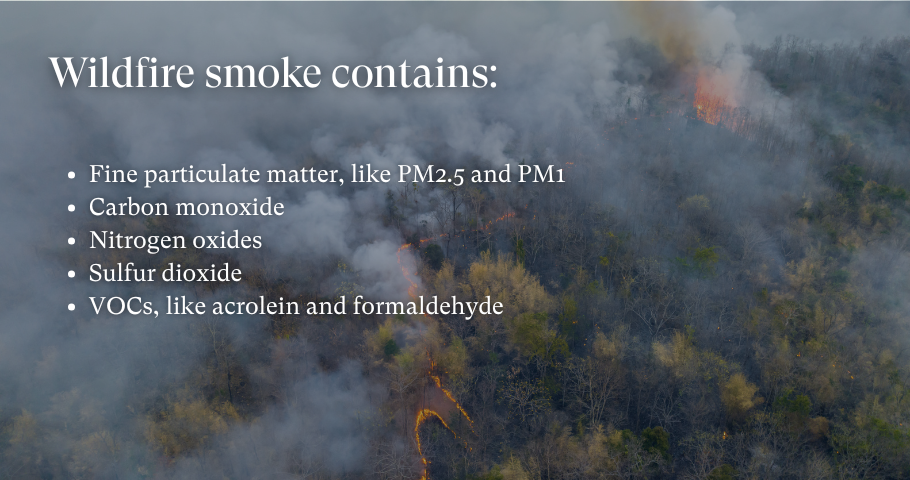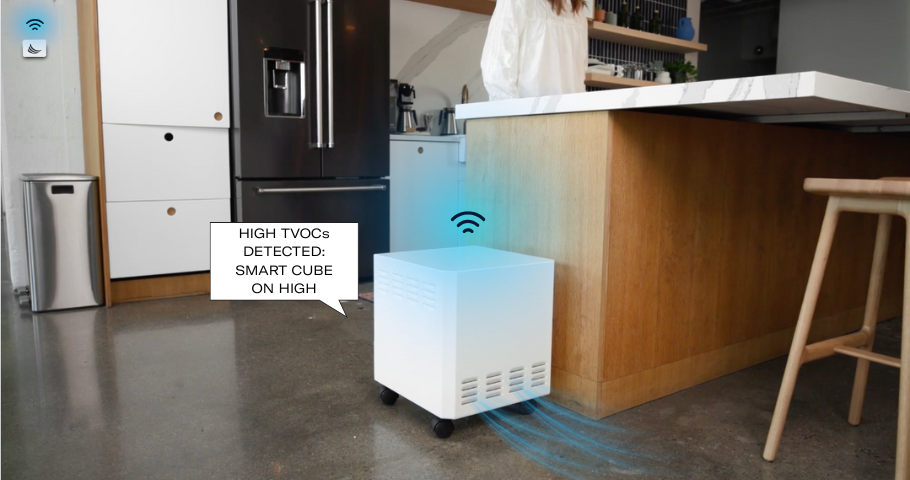How Wildfire Smoke Impacts Your Lungs- & What Wildfire AQI Can’t Show Inside Your Home
As climate change drives longer, more intense wildfire seasons, public attention rightly turns to the AQI — the Air Quality Index — as a daily safety gauge. But while the wildfire AQI might alert you to the visible danger outside, it often overlooks what’s happening where you spend most of your time: inside your home.
If you’re relying solely on the AQI app to make decisions about your health and environment, you’re only seeing half the picture. This article explains why PM2.5 exposure from wildfire smoke is so dangerous, what the AQI isn’t telling you about your indoor air, and how to truly protect your lungs with effective smoke purification strategies.
What Wildfire AQI Measures — and What It Misses
The wildfire AQI reflects outdoor pollution levels based on a combination of key air pollutants, especially fine particulate matter known as PM2.5 — tiny particles 2.5 microns or smaller that can penetrate deep into the lungs.
While AQI readings are incredibly useful for gauging outdoor risks, they don’t account for what’s actually happening inside your home. And here’s the reality: smoke seeps indoors more easily than you think — through vents, door cracks, HVAC systems, and even microscopic gaps in building materials.
These fine particles are just one type of air pollutant. Wildfire smoke can also carry gases like carbon monoxide, which can be especially harmful when it accumulates indoors.
Wildfire smoke also contains harmful gases like nitrogen oxides and sulfur dioxide, which contribute to respiratory irritation and worsen indoor air quality.

Why PM2.5 Exposure Is So Harmful to Your Lungs
PM2.5 exposure, a major component of particle pollution, is considered one of the most harmful forms of air pollution. Because the particles are so small, they bypass your nose’s natural filtering and lodge deep in your lungs — sometimes entering your bloodstream.
These tiny particles, along with gases such as nitrogen dioxides, penetrate deep into the lungs and increase risks of respiratory and cardiovascular problems.
According to the EPA, prolonged or repeated exposure can:
- Trigger asthma or bronchitis
- Increase risk of heart and lung disease
- Worsen pre-existing conditions like COPD
The CDC warns that PM2.5 exposure from wildfire smoke increases health risks, especially for people with heart or lung disease.
In fact, recent studies link sustained wildfire smoke exposure with long-term declines in lung function and an increased likelihood of developing chronic lung disease, according to the WHO. Over time, air pollutants from wildfires may even increase your risk for developing lung cancer, especially with cumulative exposure over multiple fire seasons.
Indoor vs Outdoor AQI: The Hidden Risk
Many people assume they’re safe inside if the windows are closed and the AQI outside is high — but air pollution from wildfires doesn’t stop at your front door.
Indoor vs outdoor AQI levels can sometimes be shockingly similar — especially in homes without good air sealing, proper filtration, or upgraded air conditioners capable of filtering fine particles like PM2.5.
Here’s why:
- Wildfire smoke particles can infiltrate indoor spaces quickly.
- Indoor sources like candles, cooking, or cleaning products can compound the issue.
- Most HVAC systems don’t include fine particulate filtration by default.
Harvard research and IQAir’s global study confirm wildfire smoke particles can infiltrate indoor spaces quickly, elevating indoor air pollution levels to those seen outdoors.
For more guidance, refer to the EPA’s official indoor air quality recommendations.
The result? Even without a visible haze, respiratory irritants and microscopic threats may still be affecting your respiratory system behind closed doors.
How to Measure Indoor Air Quality During Wildfire Season
To truly understand your risk, you need to measure the air inside your home. This is where many people miss the mark by relying only on the wildfire AQI app.
A smart air cleaner or air quality monitor can help track:
- Indoor PM2.5 levels
- VOCs and chemical pollutants
- CO₂ and humidity (which affect how pollutants behave)
Comparing your indoor vs outdoor wildfire AQI during smoke events helps you know when your home needs intervention — and when your purification strategies are working.
If your monitor shows elevated indoor PM2.5 levels, using an air purifier is your first and most effective line of defense.

Smoke Purification: How to Actually Clear the Air
Here’s how to make smoke purification effective, not just performative:
1. Use a True HEPA Air Purifier
Look for a purifier rated for PM2.5 and wildfire smoke. True HEPA filters remove 99.97% of fine particulates, the primary form of particle pollution. Some also include activated carbon filters for neutralizing smoke odors and gases.
Place purifiers in key rooms — especially bedrooms — and run them 24/7 during wildfire events.
Need help choosing a purifier? The EnviroKlenz SMART Cube™ is designed to capture PM2.5 and neutralize harmful chemicals from wildfire smoke using a combination of hospital-grade HEPA filtration and patented earth mineral technology. Plus, its complementary SMART IAQ Sensor actively tracks indoor risks like wildfire smoke and high particulate levels indoors, automating responsive air filtration when it is needed most on wildfire risk and poor AQI days.
2. Seal and Control Airflow
Prevent outside air from seeping in:
- Use weather stripping on doors and windows.
- Cover fireplace flues.
- Close outdoor air intake vents on HVAC systems (if possible).
- Avoid vacuuming or activities that stir up dust during smoke episodes.
3. Avoid Indoor Pollutants
During wildfire events, minimize any added burden on indoor air. Skip:
- Burning candles or incense
- Cooking high-heat meals without ventilation
- Using strong cleaning chemicals
Even without wildfire smoke, these can worsen indoor AQI and increase irritation during PM2.5 exposure events.
National Library of Medicine studies show how prolonged exposure to particulate matter significantly worsens conditions like asthma and other respiratory diseases.
Wildfire AQI Is Just the Start — Not the Solution
Relying solely on the wildfire AQI is like checking the weather but not dressing for it. It’s a signal — not a solution.
Protecting your lungs means closing the loop: understanding both outdoor and indoor AQI – beyond just wildfire AQI alerts -, recognizing the threat of PM2.5 exposure, and implementing true smoke purification methods that target dangerous air pollutants.
Take Action: Your Indoor Air Checklist
- Monitor indoor PM2.5 levels with a smart air quality device
- Use HEPA-based air purifier for smoke purification in every major living space
- Compare indoor vs outdoor wildfire AQI during smoke events
- Keep windows/doors sealed and limit ventilation to filtered air
- Avoid any activity that worsens indoor air while smoke is present
- Use an N95 mask when going outside during heavy smoke to protect your respiratory system from harmful particulate matter.
The AAFA also provides wildfire-specific health tips for people with asthma and allergies.
Final Thoughts on Keeping Indoor Air Clean from Wildfire Smoke
You can’t stop the smoke outside — but you can control the air you breathe inside.
With climate change fueling more frequent and severe wildfires, it’s time to upgrade from awareness to action. Understanding the limits of the wildfire AQI, measuring your PM2.5 exposure, and implementing true smoke purification methods will help protect your lungs — and your peace of mind — no matter what’s happening outside your window.
For more science-backed recommendations on keeping indoor air clean, visit the Environmental Working Group’s air quality guide.
